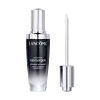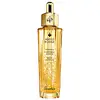Lancôme Advanced Génifique Youth Activating Concentrate Versus Guerlain Abeille Royale Advanced Youth Watery Oil
What's inside
What's inside
 Key Ingredients
Key Ingredients

 Benefits
Benefits

 Concerns
Concerns

 Ingredients Side-by-side
Ingredients Side-by-side

Water
Skin ConditioningBifida Ferment Lysate
Skin ConditioningGlycerin
HumectantAlcohol Denat.
AntimicrobialDimethicone
EmollientHydroxyethylpiperazine Ethane Sulfonic Acid
BufferingAscorbyl Glucoside
AntioxidantSodium Hyaluronate
HumectantSodium Hydroxide
BufferingSodium Benzoate
MaskingPhenoxyethanol
PreservativeAdenosine
Skin ConditioningFaex Extract
Skin ConditioningPEG-20 Methyl Glucose Sesquistearate
EmulsifyingPEG-60 Hydrogenated Castor Oil
EmulsifyingSalicyloyl Phytosphingosine
Skin ConditioningAmmonium Polyacryloyldimethyl Taurate
Emulsion StabilisingLimonene
PerfumingXanthan Gum
EmulsifyingCaprylyl Glycol
EmollientDisodium EDTA
Octyldodecanol
EmollientCitronellol
PerfumingParfum
MaskingWater, Bifida Ferment Lysate, Glycerin, Alcohol Denat., Dimethicone, Hydroxyethylpiperazine Ethane Sulfonic Acid, Ascorbyl Glucoside, Sodium Hyaluronate, Sodium Hydroxide, Sodium Benzoate, Phenoxyethanol, Adenosine, Faex Extract, PEG-20 Methyl Glucose Sesquistearate, PEG-60 Hydrogenated Castor Oil, Salicyloyl Phytosphingosine, Ammonium Polyacryloyldimethyl Taurate, Limonene, Xanthan Gum, Caprylyl Glycol, Disodium EDTA, Octyldodecanol, Citronellol, Parfum
Water
Skin ConditioningGlycerin
HumectantPolyglycerin-3
Humectant1,2-Hexanediol
Skin ConditioningAlcohol
AntimicrobialPolysorbate 20
EmulsifyingPentylene Glycol
Skin ConditioningMel
EmollientRoyal Jelly
Mannitol
HumectantCellulose
AbsorbentChlorphenesin
AntimicrobialParfum
MaskingPolyacrylate Crosspolymer-6
Emulsion StabilisingPropanediol
SolventTrisodium Ethylenediamine Disuccinate
Sodium Citrate
BufferingCitric Acid
BufferingBiosaccharide Gum-2
Skin ConditioningTocopheryl Acetate
AntioxidantMaltodextrin
AbsorbentAdenosine
Skin ConditioningCaprylic/Capric Triglyceride
MaskingAcrylates/Ammonium Methacrylate Copolymer
Synthetic Fluorphlogopite
Triethyl Citrate
MaskingCI 77891
Cosmetic ColorantSodium Benzoate
MaskingBiosaccharide Gum-1
HumectantSodium Metabisulfite
AntioxidantCI 77492
Cosmetic ColorantPotassium Sorbate
PreservativeCI 77491
Cosmetic ColorantHydroxypropyl Methylcellulose
Emulsion StabilisingTin Oxide
AbrasiveWater, Glycerin, Polyglycerin-3, 1,2-Hexanediol, Alcohol, Polysorbate 20, Pentylene Glycol, Mel, Royal Jelly, Mannitol, Cellulose, Chlorphenesin, Parfum, Polyacrylate Crosspolymer-6, Propanediol, Trisodium Ethylenediamine Disuccinate, Sodium Citrate, Citric Acid, Biosaccharide Gum-2, Tocopheryl Acetate, Maltodextrin, Adenosine, Caprylic/Capric Triglyceride, Acrylates/Ammonium Methacrylate Copolymer, Synthetic Fluorphlogopite, Triethyl Citrate, CI 77891, Sodium Benzoate, Biosaccharide Gum-1, Sodium Metabisulfite, CI 77492, Potassium Sorbate, CI 77491, Hydroxypropyl Methylcellulose, Tin Oxide
 Reviews
Reviews

Ingredients Explained
These ingredients are found in both products.
Ingredients higher up in an ingredient list are typically present in a larger amount.
Adenosine is in every living organism. It is one of four components in nucleic acids that helps store our DNA.
Adenosine has many benefits when used. These benefits include hydrating the skin, smoothing skin, and reducing wrinkles. Once applied, adenosine increases collagen production. It also helps with improving firmness and tissue repair.
Studies have found adenosine may also help with wound healing.
In skincare products, Adenosine is usually derived from yeast.
Learn more about AdenosineGlycerin is already naturally found in your skin. It helps moisturize and protect your skin.
A study from 2016 found glycerin to be more effective as a humectant than AHAs and hyaluronic acid.
As a humectant, it helps the skin stay hydrated by pulling moisture to your skin. The low molecular weight of glycerin allows it to pull moisture into the deeper layers of your skin.
Hydrated skin improves your skin barrier; Your skin barrier helps protect against irritants and bacteria.
Glycerin has also been found to have antimicrobial and antiviral properties. Due to these properties, glycerin is often used in wound and burn treatments.
In cosmetics, glycerin is usually derived from plants such as soybean or palm. However, it can also be sourced from animals, such as tallow or animal fat.
This ingredient is organic, colorless, odorless, and non-toxic.
Glycerin is the name for this ingredient in American English. British English uses Glycerol/Glycerine.
Learn more about GlycerinParfum is a catch-all term for an ingredient or more that is used to give a scent to products.
Also called "fragrance", this ingredient can be a blend of hundreds of chemicals or plant oils. This means every product with "fragrance" or "parfum" in the ingredients list is a different mixture.
For instance, Habanolide is a proprietary trade name for a specific aroma chemical. When used as a fragrance ingredient in cosmetics, most aroma chemicals fall under the broad labeling category of “FRAGRANCE” or “PARFUM” according to EU and US regulations.
The term 'parfum' or 'fragrance' is not regulated in many countries. In many cases, it is up to the brand to define this term.
For instance, many brands choose to label themselves as "fragrance-free" because they are not using synthetic fragrances. However, their products may still contain ingredients such as essential oils that are considered a fragrance by INCI standards.
One example is Calendula flower extract. Calendula is an essential oil that still imparts a scent or 'fragrance'.
Depending on the blend, the ingredients in the mixture can cause allergies and sensitivities on the skin. Some ingredients that are known EU allergens include linalool and citronellol.
Parfum can also be used to mask or cover an unpleasant scent.
The bottom line is: not all fragrances/parfum/ingredients are created equally. If you are worried about fragrances, we recommend taking a closer look at an ingredient. And of course, we always recommend speaking with a professional.
Learn more about ParfumSodium Benzoate is a preservative. It's used in both cosmetic and food products to inhibit the growth of mold and bacteria. It is typically produced synthetically.
Both the US FDA and EU Health Committee have approved the use of sodium benzoate. In the US, levels of 0.1% (of the total product) are allowed.
Sodium benzoate works as a preservative by inhibiting the growth of bacteria inside of cells. It prevents the cell from fermenting a type of sugar using an enzyme called phosphofructokinase.
It is the salt of benzoic acid. Foods containing sodium benzoate include soda, salad dressings, condiments, fruit juices, wines, and snack foods.
Studies for using ascorbic acid and sodium benzoate in cosmetics are lacking, especially in skincare routines with multiple steps.
We always recommend speaking with a professional, such as a dermatologist, if you have any concerns.
Learn more about Sodium BenzoateWater. It's the most common cosmetic ingredient of all. You'll usually see it at the top of ingredient lists, meaning that it makes up the largest part of the product.
So why is it so popular? Water most often acts as a solvent - this means that it helps dissolve other ingredients into the formulation.
You'll also recognize water as that liquid we all need to stay alive. If you see this, drink a glass of water. Stay hydrated!
Learn more about Water